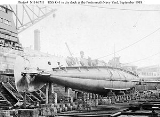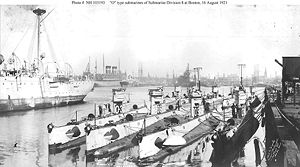
United States O class submarine
Encyclopedia
The United States Navy's O class submarines were created out of the lessons learned from the United States L class submarine
. The O class were more robust with greater power and endurance for ocean patrols. The O class were built much faster than previous classes and were commissioned in 1918. The group 2 boats entered service just before the end of World War I
. Eight of the group 1 boats survived to serve in World War II as training boats when they were recommissioned in 1941.
The class originally operated in the anti-submarine role off the USA's East Coast. Two of the boats, and , came under fire from a British merchantman in the Atlantic on 24 July 1918. The steamer scored six hits on O-4s conning tower and pressure hull before her identity was discovered. O-4 suffered minor damage caused by shell splinters. to boats formed part of the twenty-strong submarine force that left Newport, Rhode Island
on 2 November 1918 for the Azores
but the task force was recalled after the Armistice
was signed nine days later.
 The second group of boats suffered from electrical problems. was immediately sent to the Philadelphia Navy Yard for a five-month overhaul. sank the patrol boat Mary Alice in a collision while she (O-13) was submerged. also underwent a refit but was sent into reserve soon after before she went into service at Coco Solo
The second group of boats suffered from electrical problems. was immediately sent to the Philadelphia Navy Yard for a five-month overhaul. sank the patrol boat Mary Alice in a collision while she (O-13) was submerged. also underwent a refit but was sent into reserve soon after before she went into service at Coco Solo
in the Panama Canal Zone
. This also involved another overhaul. also underwent a refit soon after commissioning and later suffered a fire in her conning tower in December 1919. All of the group 2 boats were decommissioned in July 1924 and were scrapped in July 1930 under the terms of the London Naval Treaty
. however was used in an Arctic expedition by Sir Hubert Wilkins and was renamed Nautilus. After being returned to the US Navy, she was sunk in a Norwegian fjord in November 1931.
The first group served well although was rammed by a cargo ship and sunk near the Panama Canal with the loss of three crew members. All of the group 1 boats were recommissioned in 1941 to serve as training boats based at New London, Connecticut
. The remaining boats were taken out of service four months later except for which sank in deep submergence trials in June 1941. Thirty-three of her crew were lost.
United States L class submarine
The United States L class submarine was the United States Navy's first attempt at designing and building ocean-going submarines, which at the time was a yawning gap in capability compared with other major navies...
. The O class were more robust with greater power and endurance for ocean patrols. The O class were built much faster than previous classes and were commissioned in 1918. The group 2 boats entered service just before the end of World War I
World War I
World War I , which was predominantly called the World War or the Great War from its occurrence until 1939, and the First World War or World War I thereafter, was a major war centred in Europe that began on 28 July 1914 and lasted until 11 November 1918...
. Eight of the group 1 boats survived to serve in World War II as training boats when they were recommissioned in 1941.
The class originally operated in the anti-submarine role off the USA's East Coast. Two of the boats, and , came under fire from a British merchantman in the Atlantic on 24 July 1918. The steamer scored six hits on O-4s conning tower and pressure hull before her identity was discovered. O-4 suffered minor damage caused by shell splinters. to boats formed part of the twenty-strong submarine force that left Newport, Rhode Island
Newport, Rhode Island
Newport is a city on Aquidneck Island in Newport County, Rhode Island, United States, about south of Providence. Known as a New England summer resort and for the famous Newport Mansions, it is the home of Salve Regina University and Naval Station Newport which houses the United States Naval War...
on 2 November 1918 for the Azores
Azores
The Archipelago of the Azores is composed of nine volcanic islands situated in the middle of the North Atlantic Ocean, and is located about west from Lisbon and about east from the east coast of North America. The islands, and their economic exclusion zone, form the Autonomous Region of the...
but the task force was recalled after the Armistice
Armistice with Germany (Compiègne)
The armistice between the Allies and Germany was an agreement that ended the fighting in the First World War. It was signed in a railway carriage in Compiègne Forest on 11 November 1918 and marked a victory for the Allies and a complete defeat for Germany, although not technically a surrender...
was signed nine days later.

Coco Solo
Coco Solo was a United States Navy submarine base established in 1918 on the Atlantic Ocean side of the Panama Canal Zone, near Colón, Panama....
in the Panama Canal Zone
Panama Canal Zone
The Panama Canal Zone was a unorganized U.S. territory located within the Republic of Panama, consisting of the Panama Canal and an area generally extending 5 miles on each side of the centerline, but excluding Panama City and Colón, which otherwise would have been partly within the limits of...
. This also involved another overhaul. also underwent a refit soon after commissioning and later suffered a fire in her conning tower in December 1919. All of the group 2 boats were decommissioned in July 1924 and were scrapped in July 1930 under the terms of the London Naval Treaty
London Naval Treaty
The London Naval Treaty was an agreement between the United Kingdom, the Empire of Japan, France, Italy and the United States, signed on April 22, 1930, which regulated submarine warfare and limited naval shipbuilding. Ratifications were exchanged in London on October 27, 1930, and the treaty went...
. however was used in an Arctic expedition by Sir Hubert Wilkins and was renamed Nautilus. After being returned to the US Navy, she was sunk in a Norwegian fjord in November 1931.
The first group served well although was rammed by a cargo ship and sunk near the Panama Canal with the loss of three crew members. All of the group 1 boats were recommissioned in 1941 to serve as training boats based at New London, Connecticut
New London, Connecticut
New London is a seaport city and a port of entry on the northeast coast of the United States.It is located at the mouth of the Thames River in New London County, southeastern Connecticut....
. The remaining boats were taken out of service four months later except for which sank in deep submergence trials in June 1941. Thirty-three of her crew were lost.

